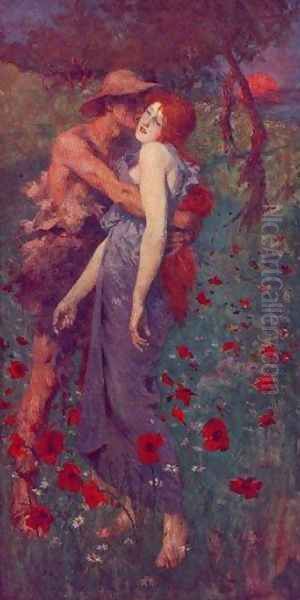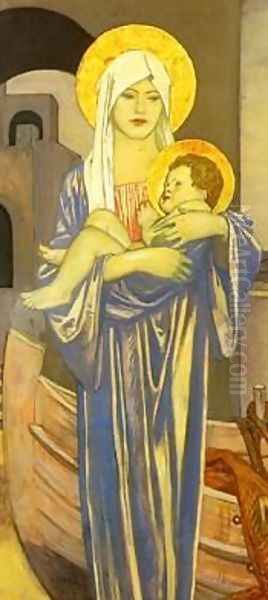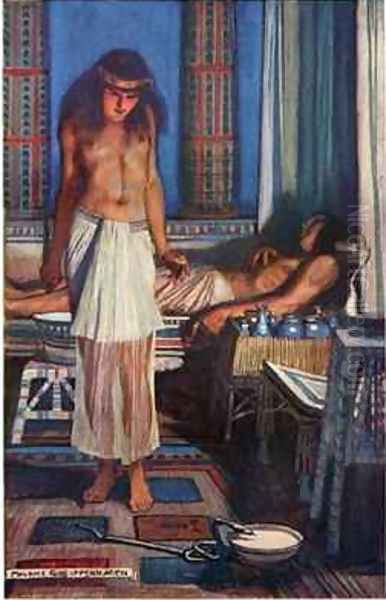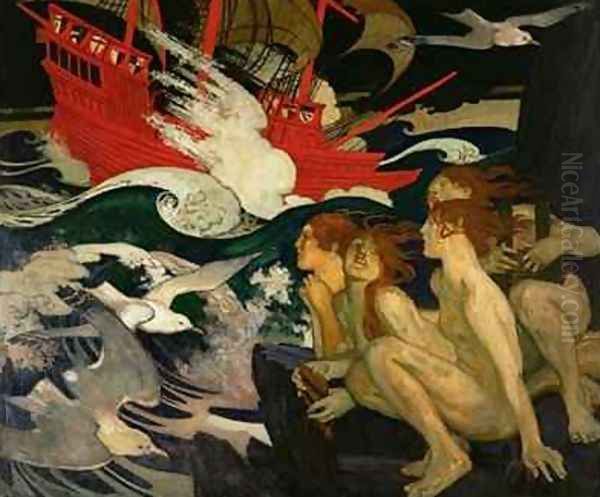Maurice William Greiffenhagen stands as a significant, if sometimes overlooked, figure in the landscape of British art during the late Victorian and Edwardian eras. A painter, illustrator, and influential teacher, Greiffenhagen navigated the shifting artistic currents of his time with a distinctive style that blended academic tradition with modern sensibilities. His career spanned book illustration, society portraiture, allegorical painting, and even poster design, showcasing a remarkable versatility. Born in London on December 15, 1862, to parents of Balkan German descent, he passed away on December 26, 1931, leaving behind a rich legacy of work and a profound impact on a generation of students.
Early Life and Academic Foundations
Greiffenhagen's artistic journey began formally in 1878 when he enrolled at the prestigious Royal Academy Schools in London. This institution was the bedrock of academic art training in Britain, emphasizing rigorous instruction in drawing from the antique and the live model, anatomy, and perspective. Here, young artists were steeped in the classical tradition and the works of Old Masters, a foundation that would underpin Greiffenhagen's work throughout his career, even as he embraced newer stylistic trends. His contemporaries at the RA Schools, or those who passed through its doors around the same period, would have included figures who went on to shape British art, such as John William Waterhouse, whose romantic and classical subjects would later resonate with Greiffenhagen's own, and Solomon J. Solomon, known for his dramatic historical scenes and portraits.
He made his debut at the Royal Academy's annual exhibition in 1884, a critical venue for any aspiring artist seeking recognition and patronage. The RA exhibitions were major social and cultural events, and to have one's work accepted was a significant step. This early exposure marked the beginning of a long association with the Academy, culminating in his election as an Associate of the Royal Academy (A.R.A.) in 1916 and a full Royal Academician (R.A.) in 1922. This progression signifies his established reputation among his peers and within the British art establishment.
The Illustrator's Craft

In the early phase of his career, Greiffenhagen distinguished himself as a talented illustrator. This was a burgeoning field in the late 19th century, fueled by the rise of illustrated magazines and the public's appetite for visually enhanced literature. He became particularly known for his illustrations for the popular adventure novels of H. Rider Haggard, an author whose tales of exotic lands and daring exploits captured the Victorian imagination. Greiffenhagen's work for Haggard, including titles like She, Allan Quatermain, and Cleopatra, demonstrated his ability to create dramatic, atmospheric scenes that complemented the narrative tension. His illustrations often featured strong chiaroscuro, dynamic compositions, and a keen sense of character.
Beyond Haggard, Greiffenhagen contributed to various periodicals, which were vital platforms for illustrators. His style in this medium was characterized by its graphic strength and narrative clarity. He was working in an era alongside other notable illustrators such as Aubrey Beardsley, whose highly stylized Art Nouveau work offered a stark contrast to Greiffenhagen's more traditional but nonetheless powerful approach, and Sidney Paget, famed for his iconic depictions of Sherlock Holmes. Greiffenhagen's illustrations for Sir Walter Scott's Ivanhoe further cemented his reputation, showcasing his skill in rendering historical detail and romantic drama. One notable later illustration, In my Horse's Hoof I Stomp on the Rider Who Never Conquered Me (1924), demonstrates his enduring power in this field.
A Shift Towards Portraiture and Idealised Scenes
From the 1890s onwards, Greiffenhagen began to pivot increasingly towards painting, particularly portraiture, which became his primary focus after 1900. This transition was common for artists who had established themselves through illustration but sought the greater prestige and artistic freedom associated with oil painting. His portraits were noted for their strong characterization and technical skill, often capturing the sitter with a sense of dignity and psychological insight. He painted notable figures of his time, including a portrait of Lieut.-Gen. Sir John Goodwin, which was exhibited at the Royal Academy in 1924.
His portrait style, while grounded in academic realism, often incorporated a richness of colour and a sensitivity to texture that reflected broader contemporary trends. He was painting portraits in an era dominated by masters like John Singer Sargent, whose dazzling brushwork and society portraits set a high bar, and Philip de László, another highly sought-after portraitist. Greiffenhagen carved his own niche, often imbuing his subjects with a thoughtful, sometimes romantic, quality.
Alongside portraiture, Greiffenhagen produced a number of "ideal" or allegorical paintings. These works allowed him to explore more imaginative themes, often drawing on mythological or literary sources, or simply creating evocative mood pieces. These paintings often showcased his skill in figure composition and his ability to convey emotion and atmosphere.
The Glasgow Years: A Professor and Mentor

A significant chapter in Greiffenhagen's career began in 1906 when he was appointed Professor in the Life Department at the renowned Glasgow School of Art (GSA). He held this influential position until 1929, shaping the training of countless young artists. The GSA, under the directorship of the visionary Francis Henry Newbery (often known as Fra Newbery), was a hotbed of artistic innovation, particularly associated with the "Glasgow Style," a distinctive variant of Art Nouveau. Greiffenhagen was invited by Newbery to head the teaching of painting, drawing, and composition from the life model.
During his tenure, Greiffenhagen worked alongside prominent figures associated with the Glasgow School, including the architect and designer Charles Rennie Mackintosh, whose groundbreaking work had already brought international acclaim to the GSA. While Greiffenhagen's own style was perhaps more traditional than that of Mackintosh or other Glasgow Style proponents like Margaret Macdonald Mackintosh or Frances Macdonald, his presence at the GSA provided students with a strong grounding in academic principles, which could then be applied to more avant-garde explorations. He was known to be a demanding but respected teacher. His assistant, David Forrester Wilson, also played a role in the teaching duties.
His colleagues at the GSA also included the Belgian Symbolist painter Jean Delville for a period, further enriching the artistic environment. The "Glasgow Boys," a group of painters including James Guthrie and Sir John Lavery who had earlier revolutionized Scottish painting with their realist and naturalist approaches, had also set a precedent for artistic dynamism in the city. Greiffenhagen's long service at the GSA underscores his commitment to art education and his role in fostering a new generation of talent.
Artistic Style: A Synthesis of Influences
Greiffenhagen's artistic style is not easily pigeonholed, as it represents a synthesis of various influences, reflecting the eclectic nature of British art at the turn of the century. A strong academic foundation is evident in his skilled draughtsmanship and compositional sense. However, he was also receptive to the romantic and decorative trends of his time.
He was notably influenced by J.W. Waterhouse, a close friend, whose works often depicted scenes from mythology and legend with a Pre-Raphaelite intensity and richness of colour. This affinity for romantic, often melancholic, themes can be seen in some of Greiffenhagen's idealised paintings. The broader influence of the Pre-Raphaelite Brotherhood, particularly figures like Dante Gabriel Rossetti (whom Greiffenhagen admired) and Sir Edward Burne-Jones, with their emphasis on literary subjects, detailed execution, and emotional depth, can be discerned as a background current in his work.

Elements of Art Nouveau, with its sinuous lines and decorative patterns, also found their way into his art, likely absorbed from the prevailing artistic climate and his association with the Glasgow School. This is particularly evident in some of his poster designs and decorative compositions. His style has been described as a highly original fusion of Art Nouveau, late Pre-Raphaelite painting, Neo-Classicism (especially in the idealized forms and balanced compositions of some works), and late Romanticism, which contributed to the dramatic and emotive qualities of his art. He also reportedly admired Venetian artists, whose mastery of colour and light would have appealed to his painterly sensibilities.
Key Works and Their Significance
Several works stand out in Greiffenhagen's oeuvre, highlighting different facets of his talent.
An Idyll (1891): This is perhaps his most famous painting and a pivotal work. It depicts a shepherd passionately embracing a nymph-like figure in a lush, pastoral landscape. The painting's sensual atmosphere and evocative mood were striking for its time. It gained further renown for its acknowledged influence on the writer D.H. Lawrence, who stated that An Idyll directly inspired his novel The White Peacock (1911). The painting's themes of raw, natural passion and its somewhat ambiguous narrative resonated deeply with Lawrence's own explorations of human relationships and the natural world. The work is now in the collection of the Walker Art Gallery, Liverpool.
The Crucifix (1926): This later religious work, now part of the Tate Britain collection (possibly also referred to as Saloon Bar in some contexts, or this might be a separate work from the same year also at the Tate), demonstrates his engagement with profound themes. His approach to religious subjects was often imbued with a sense of drama and human emotion, rather than purely devotional sentiment. He also created a notable statue of St. John, depicting the legendary test of the viper, showcasing his versatility in handling religious iconography.
Roll of Honour (Poster): Greiffenhagen was one of the first Royal Academicians to engage seriously with poster design. His Roll of Honour poster, likely created during or after World War I, is a testament to his graphic skill and his ability to create impactful public art. This foray into poster design connected him with a medium that was being revolutionized by artists like Alphonse Mucha in Paris and Ludwig Hohlwein in Germany.
Sweet lips murmurings: This painting, likely a portrait or an idealised female figure, exemplifies his skill in rendering delicate features and conveying a sense of intimacy or reverie, characteristic of his more romantic portraiture.

Mural for Braintree Town Hall (1930): Towards the end of his life, Greiffenhagen undertook a significant commission to paint a mural for the Council Chamber of the Town Hall in Braintree, Essex. The mural depicted the granting of a Royal Charter to the town in 1215. This work allowed him to engage with historical narrative on a grand scale, a tradition in British art championed by painters like Ford Madox Brown with his Manchester Town Hall murals.
His illustrations for works like Haggard's novels and Scott's Ivanhoe also remain key components of his artistic output, demonstrating his narrative power and his contribution to the "Golden Age of Illustration."
Exhibitions, Recognition, and Collections
Throughout his career, Greiffenhagen exhibited widely. His regular presence at the Royal Academy summer exhibitions was a cornerstone of his public profile in Britain. Beyond London, his work was shown internationally, with exhibitions in cities such as Munich, Dresden, and Copenhagen, indicating a broader European recognition of his talents.
His election to the Royal Academy (A.R.A. in 1916, R.A. in 1922) was a significant mark of esteem from the British art establishment. The ceremony in 1922 where he was formally inducted as a Royal Academician was shared with fellow artist Robert Anning Bell, another versatile figure known for his paintings, mosaics, and stained glass.
Today, Greiffenhagen's works are held in numerous public collections. Tate Britain holds important pieces, as does the Walker Art Gallery in Liverpool. The National Portrait Gallery in London houses at least one of his portraits, reflecting his standing in that genre. The Glasgow School of Art itself maintains a collection of his works, though tragically, a number were lost or damaged in the fires that afflicted the Mackintosh building. Nevertheless, some sixty-one works reportedly survived. Sheffield Museums also hold examples of his art. His paintings and drawings also appear on the art market, with auction houses occasionally featuring his work, ranging from preparatory sketches to finished oils.
Personal Life and Anecdotes
While much of the focus remains on his professional achievements, glimpses into Greiffenhagen's personal life offer a more rounded picture. He is known to have had a romantic relationship with Catherine Carswell, a Scottish novelist and critic who was one of his students at the Glasgow School of Art. Carswell later became known for her biography of Robert Burns and her controversial biography of D.H. Lawrence. Their relationship reportedly continued after she moved to London.
The loss of some of his works, particularly those used for teaching, in the GSA fire is a poignant reminder of the fragility of artistic heritage. These study pieces would have offered invaluable insights into his teaching methods and artistic process.
His Balkan German heritage is an interesting biographical detail, though its specific influence on his artistic outlook is not extensively documented. It does, however, place him within a broader European context, perhaps contributing to his receptiveness to continental artistic trends.
Legacy and Enduring Influence
Maurice William Greiffenhagen's legacy is multifaceted. As a painter, he created memorable images that captured the spirit of his age, from the romanticism of An Idyll to the dignified character of his portraits. His technical skill was undeniable, and his ability to synthesize various stylistic influences into a coherent personal vision was remarkable.
As an illustrator, he contributed significantly to the visual culture of the late 19th and early 20th centuries, bringing to life the narratives of popular authors and shaping the public's imagination. His work in poster design also marked him as an artist willing to engage with modern forms of visual communication.
Perhaps one of his most enduring legacies lies in his long tenure as a professor at the Glasgow School of Art. For over two decades, he guided and mentored aspiring artists, instilling in them the foundational skills of drawing and painting. While the specific names of many of his students who went on to achieve fame are not always readily listed, his impact on the artistic education of a generation in Scotland was undoubtedly profound. He provided a crucial link between the academic tradition and the burgeoning modernist impulses of the early 20th century.
Though perhaps not as widely celebrated today as some of his more avant-garde contemporaries like Walter Sickert or members of the Bloomsbury Group such as Duncan Grant or Vanessa Bell, Greiffenhagen remains an important figure for understanding the complexities and richness of British art during a period of significant transition. His ability to excel across multiple genres – illustration, portraiture, allegorical painting, and design – speaks to a versatile and dedicated artistic spirit whose contributions continue to merit appreciation and study.